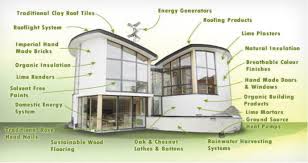The Rise of Eco-Friendly Building Materials
As the world becomes more environmentally conscious, the construction industry is also embracing sustainable practices. One key aspect of this shift is the increasing use of eco-friendly building materials. These materials offer a range of benefits, from reducing carbon footprint to improving indoor air quality.
Bamboo
Bamboo is a versatile and sustainable material that has gained popularity in construction. It grows rapidly and can be harvested without causing damage to the environment. Bamboo is strong, durable, and has natural resistance to pests, making it an ideal choice for flooring, furniture, and even structural elements.
Recycled Steel
Using recycled steel in construction helps reduce energy consumption and greenhouse gas emissions associated with traditional steel production. Recycled steel retains its strength and durability, making it a viable option for structural components in buildings.
Rammed Earth
Rammed earth construction involves compacting a mixture of earth, gravel, sand, and clay into solid walls. This method is not only environmentally friendly but also provides excellent thermal mass properties, helping regulate indoor temperatures naturally.
Cork
Cork is a renewable material harvested from the bark of cork oak trees. It is lightweight, insulating, and resistant to moisture and fire. Cork flooring is a popular choice for eco-conscious builders looking for sustainable alternatives to traditional flooring materials.
Straw Bales
Straw bales are an affordable and sustainable building material that offers excellent insulation properties. When properly sealed and finished, straw bale walls provide high thermal performance and contribute to energy efficiency in buildings.
The Future of Sustainable Construction
As awareness of environmental issues grows, the demand for eco-friendly building materials continues to rise. Innovations in sustainable construction are driving the development of new materials that prioritise resource efficiency, durability, and low environmental impact.
Sustainable Construction: Your Guide to Eco-Friendly Building Materials
- What are eco-friendly building materials?
- Why should I use eco-friendly building materials?
- What are the benefits of using eco-friendly building materials?
- Which eco-friendly building materials are most commonly used?
- How do eco-friendly building materials contribute to sustainability?
- Where can I purchase eco-friendly building materials?
What are eco-friendly building materials?
Eco-friendly building materials refer to sustainable and environmentally conscious construction products that are designed to minimise negative impacts on the environment. These materials are typically sourced from renewable resources, recycled materials, or have low carbon footprints. Eco-friendly building materials aim to reduce energy consumption, promote efficient use of resources, and improve indoor air quality. Examples include bamboo, recycled steel, rammed earth, cork, and straw bales. By choosing eco-friendly building materials, builders can contribute to creating healthier living spaces while reducing the overall environmental impact of construction projects.
Why should I use eco-friendly building materials?
Using eco-friendly building materials is essential for promoting sustainable construction practices and reducing the environmental impact of buildings. By opting for eco-friendly materials, you contribute to preserving natural resources, minimising waste generation, and lowering carbon emissions associated with traditional construction methods. Eco-friendly materials also tend to be healthier for occupants, as they often contain fewer harmful chemicals and pollutants, improving indoor air quality. Additionally, choosing sustainable building materials can lead to long-term cost savings through energy efficiency and reduced maintenance requirements. Overall, incorporating eco-friendly materials into your construction projects not only benefits the environment but also creates healthier and more efficient living spaces for generations to come.
What are the benefits of using eco-friendly building materials?
Using eco-friendly building materials offers a multitude of benefits that contribute to a more sustainable and environmentally conscious construction industry. These materials help reduce the carbon footprint of buildings by minimising energy consumption during production and promoting resource efficiency. Additionally, eco-friendly building materials often have lower levels of harmful emissions, improving indoor air quality and creating healthier living spaces for occupants. By choosing sustainable materials, builders can also support the preservation of natural resources and ecosystems, ultimately leading to a greener and more resilient built environment for future generations.
Which eco-friendly building materials are most commonly used?
When it comes to eco-friendly building materials, several options are commonly used in sustainable construction practices. Bamboo stands out as a popular choice due to its rapid growth, strength, and versatility for various applications. Recycled steel is another prevalent material that helps reduce environmental impact by reusing existing resources. Additionally, rammed earth construction, cork, and straw bales are frequently employed for their sustainable properties such as natural insulation, renewable sourcing, and energy efficiency. These materials not only contribute to lowering carbon footprint but also promote healthier indoor environments in eco-conscious building projects.
How do eco-friendly building materials contribute to sustainability?
Eco-friendly building materials play a crucial role in promoting sustainability within the construction industry. By choosing materials that are renewable, recycled, or have minimal environmental impact, builders can significantly reduce the carbon footprint of a project. These materials help conserve natural resources, decrease energy consumption during production and transportation, and minimise waste generation. Additionally, eco-friendly building materials often have superior thermal performance and durability, leading to energy-efficient buildings with reduced maintenance needs over time. Ultimately, the use of such materials not only benefits the environment but also contributes to creating healthier indoor spaces for occupants while supporting long-term sustainability goals in the built environment.
Where can I purchase eco-friendly building materials?
When it comes to sourcing eco-friendly building materials, there are several options available to consumers. Many hardware stores and home improvement centres now offer a range of environmentally friendly products, including sustainable lumber, recycled materials, and non-toxic finishes. Additionally, specialised eco-friendly building supply companies have emerged, providing a wider selection of green building materials. Online retailers also play a significant role in making eco-friendly building materials accessible to a broader audience, offering convenience and the ability to compare products and prices from the comfort of your home. By exploring these various avenues, individuals can find the right eco-friendly building materials to support their sustainable construction projects.
